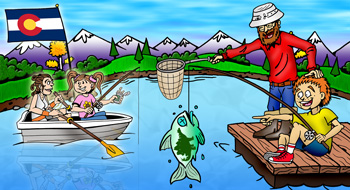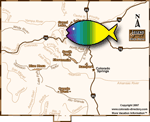Colorado Fishing Information

Colorado Fishing Information & License Fees
License Fees & Stamps | Free Fishing Days | Possession Limits | Types of Colorado Trout | How to Catch Trout in Colorado | Other Types of Fish | Fishing Conditions | Family Fishing Information | Fishing Equipment Information
Fishing License Fees*
Annual Fishing (valid 4/1 - 3/31)
Resident: $42.91
Nonresident: $120.25
Annual Senior Fishing (64 years and older)
Resident: $11.73
Nonresident: N/A
Fishing (1-Day)
Resident: $16.72
Nonresident: $20.46
Fishing (5-Day)
Resident: N/A
Nonresident: $39.17
Fishing (Additional Day)
Resident: $7.99
Nonresident: $7.99
Fishing Extra Rod Stamp (Licensed residents/nonresidents and youth under 16)
Resident: $12.98
Nonresident: $12.98
Youth Fishing (ages 16 & 17)
Resident: $11.73
Nonresident: N/A
Youth Fishing (under 16 years)
Resident: Free
Nonresident: Free
*An additional 25¢ Search & Rescue Fee and $1.50 Wildlife Education Fee will be applied to every license purchased.
Dates and fees information provided by Colorado Parks and Wildlife. For additional hunting information please visit Colorado Parks and Wildlife
Habitat Stamps
Required for persons age 18-64 buying or applying for a license (first license only).
Note: A Habitat Stamp will be added to the first license purchase of the year.
Annual Habitat Stamp (valid 4/1 - 3/31)
Resident: $12.47/yr.
Nonresident: $12.47/yr.
Lifetime Habitat Stamp
Resident: $374.47
Nonresident: $374.47
Colorado Waterfowl Stamp
Resident: $12.15
Nonresident: $12.15
Aquatic Nuisance Species (ANS) Stamp
Required for motorboats and sailboats.
ANS Stamp
Resident: $25.00/yr.
Nonresident: $50.00/yr.
Free Fishing Days
First full weekend of June: All waters of the state are open to fishing without a license.
Bag and Possession Limits
Any fish caught and placed on a stringer, in a container or in a live well or not returned to the water immediately, is counted as part of the daily bag or possession limit. Check the state regulations for bag and possession limits for the type of fish and location.
Children under the age of 16 are not required to have a fishing license and can take a full bag and possession limit.
Gold Medal & Wild Trout Fishing
Colorado has two special designations for fishing. Most of the state follows the aforementioned regulations but Gold Medal and Wild Trout waters offer a different type of experience. Catching fish in these waters requires greater knowledge of angling and usually the fish must be returned to their habitat.
Gold Medal Waters
Gold Medal Waters provide areas to catch larger trout for an enhanced fishing experience. Designated areas may have different regulations, please refer to local guidelines for detailed information.
Wild Trout Waters
Wild Trout Waters provide anglers the opportunity to catch trout in a natural environment. The fish population must sustain itself through natural reproduction and recruitment. Designated areas are limited and regulations vary, please refer to local guidelines for detailed information.
Types of Trout in Colorado:
Brown Trout: The spotting pattern is composed of black spots and also red orange spots surrounded by light blue.
Lake Trout (Mackinaw): The fish has a white, irregular spotting pattern on a dark background with veriform marking over the back and head. Unlike other trout, they have a deeply indented tail fin.
Cutthroat Trout (Native): Cutthroat have a crimson slash on either side of the throat beneath the lower jaws.
Brook Trout: The pectoral, pelvic and anal fins are often orange, edged with black & white. The body is dark with read spots and surrounded by blue and white spots.
Rainbow Trout: Identifying Marks are the black spots on a light body and a red stripe along the sides of a fish.
Kokanee Salmon: At the end of their third summer, females develop a red/grey/white pattern while males develop hook jaw and turn brick red.
How to Catch Trout in Colorado
Trout generally eat what they see, so they investigate what's moving and tempting. Spinners in lakes and streams reflect light, and can catch a trout's eye and spark its curiosity from a considerable distance. The lure doesn't matter, thought, as long as the fish grabs it either for food, because he's mad at it, out of pure curiosity or astonishment. In streams, trout wait for food to drift to them. Best fishing results occur when bait or artificial flies are carried to the fish by the current, as naturally as possible.
In lakes, trout often cruise the shallows when feeding. The best producing method is to attract the fish by movement of the lure from trolling and casting. Since fishing is a year-round endeavor in Colorado, you need to look for trout in different areas at different times of the year. No matter what time of year, though, the more cast you make into productive water and the longer you keep your lure working through the feed zone, the more fish you'll fool. Once you realize this, the only problem is finding those feeding zones, or places where fish eat.
Here are a few places to fish on the river or stream in spring and early summer:
- Where two currents meet to flow into a pool, fish the tongue, not the pool.
- Along flat or slow moving water running over pebbles, sand or stones and turning deep along one bank. Concentrate on the deep side along the bank.
- Along small rapids that appear with high water along the shoreline and which rush between rocks and are usually high and dry all summer. Try the eddies and water behind these rocks.
- Near long, shallow riffle over rocks, try the foot deep pockets between these rocks. Many fishermen pass these choice spots because they don't believe trout live in such places. Trout do.
- Near long riffles that get plenty of warm sunlight and lead into pools with good cover, such as roots or fallen trees.
First remember a trout relies almost entirely upon the current to carry food to him during the early season. He is usually lazy and sluggish. When he does feed, he'll usually pick something off the bottom of the river or stream. Thus, dropping bait or artificial fly into a suitable current and giving it slow play is certainly a step in the right direction. Fishing deep is another. Put the lure or bait right in front of the fish. Make it easy for him to eat.
When fishing in moving water, cast the bait, lure or artificial fly across the upstream into a current tongue that leads into a hole or pool. As the bait sinks, follow its progress by pointing the tip of the rod at the lure as it travels with the current. At the same time, take in any slack line that builds up. Keep the bait tumbling naturally. Gently urge it along by manipulation of the rod and line. If your line stops or you sense a slight throbbing on the line, keep the line taut, then lightly but steadily increase pressure. If the throbs become more pronounced, set the hook. The trick is to allow enough time for a hesitant trout to get the hook in his mouth, without allowing so much time that he smartens up and spits it out before you set the hook.
No problem! This is where that 30 percent learning comes from being out there fishing, and not from reading a book. Look for spots on the stream where you think trout would be holding and waiting for the next meal. Remember, they will still be close to cover, feeding, and holding areas. Trout actively feed throughout the summer. Most insect hatches occur from late spring to early fall and trout catch bugs, which rise from the bottom of the stream to hatch and fly away. Use small nymphs and wet flies to imitate these rising aquatic insects. Cast upstream, using some weight on your line. Try to get the artificial fly down as fast as possible. Let it bounce on the bottom, dead drift, following the fly with you rod tip, lowering your rob tip as it floats down stream. If you don't attract fish by the time the fly has moved below you, raise the rod tip and strip the fly back to you. This will provide action to the fly, as if an aquatic insect was about to hatch. Then, hang on. If you see trout rising to small flies on the surface, use a dry fly to imitate the size and color of those live flies.
During these productive fishing months, lures and spinners also work upstream, let the lure sink as much as possible, then make it swim. Give the trout something to attack. Lakes and reservoirs are productive as well while the trout may not be on the bottom of the lake, they've got to be in there somewhere. If you are shore fishing, cast out, count to five, then reel your lure in. If that doesn't work cast out, count to seven, then reel your lure in. Then try 12 seconds, or 15 seconds. What ever it takes. The trout will be found in a certain "zone" on the lake. The counting methods help you keep track of where that zone is.
Insect hatches are about gone in the fall, although fly-fishing is still very good. Trout are trying to fatten up for the winter, so they're going after just about any food source they can find.
Other Types of Fish in Colorado: Reservoirs and Lakes
Bass (Largemouth): Jaw extends past the eye and a horizontal stripe on their body. Largemouth Bass have exceeded 10 pounds in Colorado and are known for their aggressive predatory behavior.
Bluegill: This is a sunfish and has a short and deep body. The top dorsal fin is not split. They have a small mouth, a short head and a dark gill flap with no trim. There are parallel vertical bars on the side with long, pointed pectoral fins on the side. Males breeding colors are brilliant blue fins and a red-orange stomach. Female bluegills are dark on the back with vertical stripes on the body.
Carp: The common carp is a heavy-bodied minnow with barbels on either side of the upper jaw. The color usually varies from brassy green or yellow, to golden brown, or even silvery. Their bellies are usually yellowish-white. The dorsal fin with 17-21 rays, and the anal fin both have a heavy toothed spine.
Catfish: Easily identified by their barbels (whiskers), forked tail and light random black spots.
Crappie: These are pan-shaped fish with black splotches over a silver background, the dorsal spines and rays get longer as they approach the tail.
Muskie (Tiger): Long snout filled with teeth and dark tiger striped sides on the side with a light body.
Perch (Yellow): Yellow perch have two separate dorsal fins with large vertical dark stripes on their yellowish sides.
Saugeye: Distinguished by black mottling marks on their bodies, tails that do not have a white tip and black pigmentation in between dorsal spines.
Walleye: Look for two separate dorsal fins and a white tipped tail.
Wiper: Have six to eight dark horizontal stripes over a silver-white background and a dark charcoal to black back. They also have two dorsal fins, the anterior with 8-10 sharp spines.
Learn About Colorado's Fishing Conditions
Colorado's fishing conditions and stocking report
Colorado Parks and Wildlife fishing awards and records
Colorado's Family Fishing Information
Choosing the Right Fishing Equipment
Colorado's fishing conditions and stocking report
Colorado Parks and Wildlife fishing awards and records



